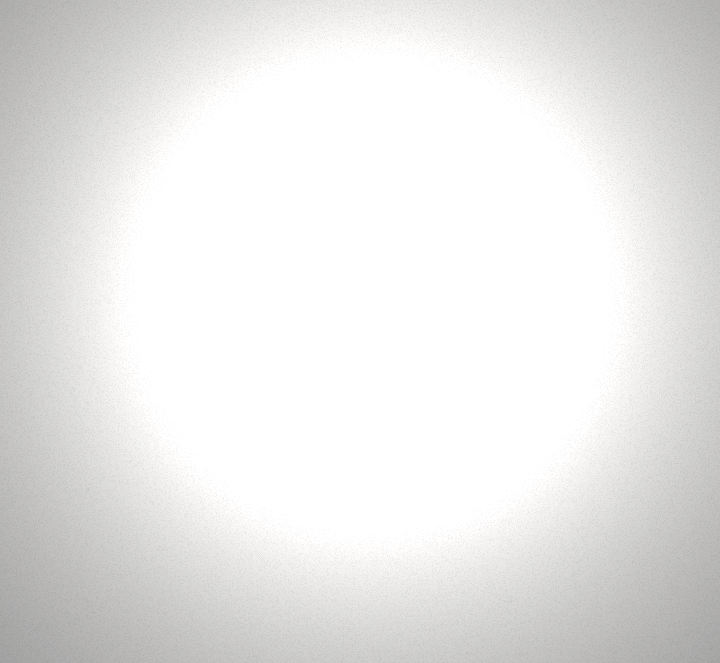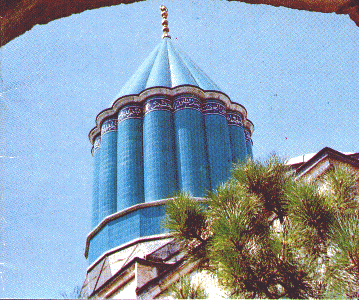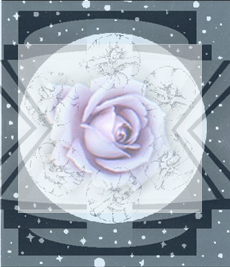

| 786 The Zahuri Web Site Konya - Traveller's Guide |
Konya index
Konya photos index
Traveller's Guide
Masnevi
| The dome of the shrine of Mevlana Jalaluddin Rumi |
Konya, The City of Mevlana Jalaludin Rumi
It is hoped that this page will give useful information for people with an interest in sufism who plan to travel to
Konya, Turkey from the UK. Every attempt will be made to ensure the information is up to date and accurate
but we cannot accept responsibility for any changes that may occur of which we are unaware.
TRAVEL FROM THE UK.
Konya is accessible by air, rail and bus. We have always used the excellent Turkish coach system which is
extremely inexpensive and of a quality comparable with or better than many European coaches. Most ordinary
flights from the UK go via Istanbul. From Istanbul Airport you will require either a taxi or a local airport bus to
go to the main coach station (Terminale) (£8 -12). Coaches to Konya are easily available from a number of
bus companies such as KAMAL KOC and even up to midnight you may usually find only a relatively short
delay before getting a coach to Konya. You may go via Ankara, though more direct coaches are also
available from companies like KONTUR, SET, or COSMO TUR. In general it is about a 10/11 hour journey
from Istanbul. I believe it is possible also to fly to Ankara or to Konya itself but you will still have to change
flights at Istanbul. A train with sleeping berth is a comfortable, though slower way to travel. As of 2014 there
are bullet trains that make the journey in 6 hours but I have never used this..
Alternatively at some times of the year (May to September) you may take a chartered holiday flight to
Dalaman or Antalya. These can often be found very cheaply at perhaps £150.00 (1999 price) or less from the
UK. From Dalaman airport you will have to get a taxi to Dalaman from where there are a number of routes to
Konya which require at least one change of bus. Probably the best route is to take a small local bus to
Fethya, from where you can pick up a larger coach either direct to Konya or via Antalya. Altogether an 11
hour journey on the coach.
Flights to Antalya would require only a four or five hour bus journey to reach Konya by direct bus. However
most charter flights from the UK seem to go to Dalaman.
The bus terminal in Konya is situated a good distance from the city centre. You will need to take a dolmish (a
local mini bus) or a taxi into town. There is a reliable English speaking taxi driver you could try; phone
SUFI SHRINES IN KONYA
Of course the main attraction of Konya is the majestic Tomb of 'Mevlana' as Hz Jalaluddin Rumi is usually
known locally. However before visiting this shrine it is considered important to first visit the smaller building
about half a mile away where Mevlana's beloved Shemsuddin Tabrizi lies buried. There are a number of
instances in Sufism where the visiting of another shrine first is essential if you want to get the most spiritual
blessing from the saint. Hz Shem's tomb is less grand in appearance than Mevlana's Turbisi (shrine) and can
be found within what is now a small mosque. It has an extremely peaceful and spiritually uplifting atmosphere
and is an excellent place for quiet contemplation. Unless you are intending to offer ritual prayers there it is of
course advisable to choose your time so as not to coincide with the prayers. Given the mystery surrounding
the passing from this world of Shemsuddin Tabrizi we do not propose to comment on questions concerning
authenticity of tombs - at all events it is, without doubt, a place held sacred to him.
Following this visit you can walk the short distance to Mevlana's imposing shrine. It is officially a museum and
payment for entry is usually required. There are often bus-loads of tourists from every corner of the globe as
well as of Turkish people themselves. Despite this the atmosphere inside can be found to be awe inspiring.
There are bags that be used as covering for the shoes available at the entrance to the shrine itself. It is open
from 9.30am - 12.00 noon and 1.30pm - 5.00pm though during the featival things are sometimes relaxed and
last year entrance was free. The normal charge is about £1. (3TL).
There are a large number of tombs within the main room (known as the chamber of Presence) and nearby to
Mevlana's dominating shrine. How you maintain the respectful reverence within this apparently commercial
environment is of course a matter for you. The place where visitors traditionally knelt and kissed near the foot
of the shrine is officially cordoned off and the most usual way is to offer a brief fatiha or prayer in front of the
shrine. Access to kissing a step at the foot of the shrine of Mevlana is given once a year during the height of
the Festival (Ur'us) celebrations - an occasion that draws a very large crowd. There are a number of shrines
within the main building and a small map can help you locate specific shrines. Sultan Veled, his son and a
later successor lies buried beneath the tomb immediately adjacent to Mevlana.
There are two other large rooms - one originally a Sema hall and the other a mosque. In these there are
exhibits of various sacred relics including the hat of Shemsuddin. the mosque area on my last visit had been
changed from an exhibition hall to a prayer area - I do not know if this is permanent. There are many early
copies of both Qur'ans and copies of the Masnavi as well as other books. There is a silver casket said to
contain a hair from the beard of the holy Prophet Muhammad (saw). There are numerous other artifacts
including a gigantic Tasbih (rosary). In the courtyard there are some other things of interest including a place
to perform ablutions and a drinking tap. There are rooms set out as exhibitions off a corridor partly
surrounding the courtyard, showing with models how life in the Turbisi may have looked at one time.
From time to time there are art or craft exhibitions where calligraphy and fine art etc can be purchased. Some
relics such as the hat of Hz Shems can be seen in these rooms.
The kiosk from which books and souvenirs can be purchased is no longer in the grounds and I have not found
anywhere else yet where you can purchase the magnificent, but very weighty, facsimile of the Masnavi (in
Persian of course) with high quality reproductions of both text and early decorative pages. Such books are
priceless, but in this case the astonishingly moderate price makes it a bargain in more than one sense. There
are also displays with wax models in the surrounding rooms. For more detailed information on the shrine area
see page 427 - 431 of RUMI - PAST AND PRESENT, EAST AND WEST by Franklin D. Lewis (One World,
Oxford . 2000: isbn 1 85168 214 7).Also much interesting information on Mevlana and the Mevlevis.
Additionally Mevlana's Life, Works and The Mevlana Museum (ISBN 975 00100 1 9) by Dr Erol contains
much detailed and fascinating information.
The following web sites contain pictures of interest:-
http://www.kto.org.tr/mevlana/resim.hmt
http://www..ege.edu.tr/Turkiye/si/Konya.html
GETTING AROUND
Once you have visited these two shrines you may be interested to visit some of the other smaller shrines in
the surrounding area. This can be done very inexpensively by bus or by a small local bus (Dolmisch) however
the shrines are not so easy to find unless you know what you are looking for. The shrines include that of
Hazrat Sadruddin Konevi, near the sports stadium, Hazrat Atazbashvelli, on the road to Mehram near the
University campus and Hazrat Tavus Baba and Hazrat Cemil Ali at Mehram. There is also a shrine to
Mevlana's doctor (Hakim Effendi) situated just of the main shopping area in Aleidin. Nearby to the Mevlana
shrine is a local graveyard in which can be found the graves of more recent Mevlevi and other Sufi saints as
well as the local people.
One of our web site members is a very helpful local, English speaking, taxi driver whose base is just across
the big roundabout from the Mevlana shrine - opposite the Dergah Hotel. (Abdullah, Altin Taksi).
There are many hotels in Konya and prices vary greatly. Personally I have always used the Dergah Hotel for
its closeness to the Mevlana Shrine but it is being rebuilt. There are numerous carpet and kilim shops in
Konya and splendid old Turkish markets. There are also a number of interesting museums, traditional
Turkish baths, and many splendid Mosques including the Selimiya Mosque adjacent to Mevlana's shrine.
At the rear of the shrine there are buildings of the Mevlevi Foundation. They also provide nearby a place for
free tea.
Outside of the tourist kiosks it is not easy to find books in English. However there are two or three excellent
bookshops that do stock interesting tapes and discs just off the main Aleiddin shopping area which is located
just next to the Aleiuddin Hill at the far end of the road (Mevlana Caddesi) leading from Mevlana's tomb. There
are also books available in the foyer of the main Sema hall. There is an underground shopping mall on the
Caddesi itself which deals entirely with gold jewelry. In addition to the ubiquitous carpet shops, there are
excellent ceramics available, and leather jackets and coats, so common in Turkey, are generally at
reasonable prices. As always a little bargaining over a cup of tea can be beneficial.
There are people belonging to various Sufi orders to be found throughout Turkey and especially in Konya,
however Sufism is technically illegal in Turkey so I hope you will forgive me for not mentioning specific names
or addresses on an open website.
FESTIVAL WEEK
Of course the main festival usually associated with Mevlana takes place in the ten days leading up to and
including 17th December. Hotel prices vary of course from £30 upwards per night according to the level of
comfort required. The large luxury hotels can be very expensive. It is a busy time and advance booking in
hotels is advisable. The Pensions are much cheaper than hotels of course. The beautiful and dramatic Sema
Performances of whirling are ticketed affairs if you hope to get a seat for the final performance on the 17th
you are advised to try to book before leaving the UK.The performances are held in a spectacular large new
purpose built venue. This is located about a mile or so down the road from the Mevlana shrine. The tourist
office close by the Mevlana shrine will have information on where to get tickets. Don't be put off by the
ceremony's commercialization, it is still an impressive event. The large new centre has regular alternative
cultural events such as music concerts from groups of different nationalitise and talks (occasionally in
English). Smaller unofficial gatherings can also be found throughout the many hotels in Konya.and you will
find many in the carpet shops who can help visitors with this (or indeed with tickets etc).
A visit to Karaman (about an hour and half away) brings with it the opportunity to visit the much venerated
shrine of Mevlana's mother and also the shrine of the great Sufi poet Yunus Emre.
I hope what has been written here may be helpful to a person interested in Sufism who may be planning a visit
to this wonderful city for the first time. However it is worth bearing in mind the well established belief amongst
Sufis that only those who are invited by Mevlana may actually get there.
Jamiluddin Morris Zahuri (October '98, updated 2015)
It is hoped that this page will give useful information for people with an interest in sufism who plan to travel to
Konya, Turkey from the UK. Every attempt will be made to ensure the information is up to date and accurate
but we cannot accept responsibility for any changes that may occur of which we are unaware.
TRAVEL FROM THE UK.
Konya is accessible by air, rail and bus. We have always used the excellent Turkish coach system which is
extremely inexpensive and of a quality comparable with or better than many European coaches. Most ordinary
flights from the UK go via Istanbul. From Istanbul Airport you will require either a taxi or a local airport bus to
go to the main coach station (Terminale) (£8 -12). Coaches to Konya are easily available from a number of
bus companies such as KAMAL KOC and even up to midnight you may usually find only a relatively short
delay before getting a coach to Konya. You may go via Ankara, though more direct coaches are also
available from companies like KONTUR, SET, or COSMO TUR. In general it is about a 10/11 hour journey
from Istanbul. I believe it is possible also to fly to Ankara or to Konya itself but you will still have to change
flights at Istanbul. A train with sleeping berth is a comfortable, though slower way to travel. As of 2014 there
are bullet trains that make the journey in 6 hours but I have never used this..
Alternatively at some times of the year (May to September) you may take a chartered holiday flight to
Dalaman or Antalya. These can often be found very cheaply at perhaps £150.00 (1999 price) or less from the
UK. From Dalaman airport you will have to get a taxi to Dalaman from where there are a number of routes to
Konya which require at least one change of bus. Probably the best route is to take a small local bus to
Fethya, from where you can pick up a larger coach either direct to Konya or via Antalya. Altogether an 11
hour journey on the coach.
Flights to Antalya would require only a four or five hour bus journey to reach Konya by direct bus. However
most charter flights from the UK seem to go to Dalaman.
The bus terminal in Konya is situated a good distance from the city centre. You will need to take a dolmish (a
local mini bus) or a taxi into town. There is a reliable English speaking taxi driver you could try; phone
SUFI SHRINES IN KONYA
Of course the main attraction of Konya is the majestic Tomb of 'Mevlana' as Hz Jalaluddin Rumi is usually
known locally. However before visiting this shrine it is considered important to first visit the smaller building
about half a mile away where Mevlana's beloved Shemsuddin Tabrizi lies buried. There are a number of
instances in Sufism where the visiting of another shrine first is essential if you want to get the most spiritual
blessing from the saint. Hz Shem's tomb is less grand in appearance than Mevlana's Turbisi (shrine) and can
be found within what is now a small mosque. It has an extremely peaceful and spiritually uplifting atmosphere
and is an excellent place for quiet contemplation. Unless you are intending to offer ritual prayers there it is of
course advisable to choose your time so as not to coincide with the prayers. Given the mystery surrounding
the passing from this world of Shemsuddin Tabrizi we do not propose to comment on questions concerning
authenticity of tombs - at all events it is, without doubt, a place held sacred to him.
Following this visit you can walk the short distance to Mevlana's imposing shrine. It is officially a museum and
payment for entry is usually required. There are often bus-loads of tourists from every corner of the globe as
well as of Turkish people themselves. Despite this the atmosphere inside can be found to be awe inspiring.
There are bags that be used as covering for the shoes available at the entrance to the shrine itself. It is open
from 9.30am - 12.00 noon and 1.30pm - 5.00pm though during the featival things are sometimes relaxed and
last year entrance was free. The normal charge is about £1. (3TL).
There are a large number of tombs within the main room (known as the chamber of Presence) and nearby to
Mevlana's dominating shrine. How you maintain the respectful reverence within this apparently commercial
environment is of course a matter for you. The place where visitors traditionally knelt and kissed near the foot
of the shrine is officially cordoned off and the most usual way is to offer a brief fatiha or prayer in front of the
shrine. Access to kissing a step at the foot of the shrine of Mevlana is given once a year during the height of
the Festival (Ur'us) celebrations - an occasion that draws a very large crowd. There are a number of shrines
within the main building and a small map can help you locate specific shrines. Sultan Veled, his son and a
later successor lies buried beneath the tomb immediately adjacent to Mevlana.
There are two other large rooms - one originally a Sema hall and the other a mosque. In these there are
exhibits of various sacred relics including the hat of Shemsuddin. the mosque area on my last visit had been
changed from an exhibition hall to a prayer area - I do not know if this is permanent. There are many early
copies of both Qur'ans and copies of the Masnavi as well as other books. There is a silver casket said to
contain a hair from the beard of the holy Prophet Muhammad (saw). There are numerous other artifacts
including a gigantic Tasbih (rosary). In the courtyard there are some other things of interest including a place
to perform ablutions and a drinking tap. There are rooms set out as exhibitions off a corridor partly
surrounding the courtyard, showing with models how life in the Turbisi may have looked at one time.
From time to time there are art or craft exhibitions where calligraphy and fine art etc can be purchased. Some
relics such as the hat of Hz Shems can be seen in these rooms.
The kiosk from which books and souvenirs can be purchased is no longer in the grounds and I have not found
anywhere else yet where you can purchase the magnificent, but very weighty, facsimile of the Masnavi (in
Persian of course) with high quality reproductions of both text and early decorative pages. Such books are
priceless, but in this case the astonishingly moderate price makes it a bargain in more than one sense. There
are also displays with wax models in the surrounding rooms. For more detailed information on the shrine area
see page 427 - 431 of RUMI - PAST AND PRESENT, EAST AND WEST by Franklin D. Lewis (One World,
Oxford . 2000: isbn 1 85168 214 7).Also much interesting information on Mevlana and the Mevlevis.
Additionally Mevlana's Life, Works and The Mevlana Museum (ISBN 975 00100 1 9) by Dr Erol contains
much detailed and fascinating information.
The following web sites contain pictures of interest:-
http://www.kto.org.tr/mevlana/resim.hmt
http://www..ege.edu.tr/Turkiye/si/Konya.html
GETTING AROUND
Once you have visited these two shrines you may be interested to visit some of the other smaller shrines in
the surrounding area. This can be done very inexpensively by bus or by a small local bus (Dolmisch) however
the shrines are not so easy to find unless you know what you are looking for. The shrines include that of
Hazrat Sadruddin Konevi, near the sports stadium, Hazrat Atazbashvelli, on the road to Mehram near the
University campus and Hazrat Tavus Baba and Hazrat Cemil Ali at Mehram. There is also a shrine to
Mevlana's doctor (Hakim Effendi) situated just of the main shopping area in Aleidin. Nearby to the Mevlana
shrine is a local graveyard in which can be found the graves of more recent Mevlevi and other Sufi saints as
well as the local people.
One of our web site members is a very helpful local, English speaking, taxi driver whose base is just across
the big roundabout from the Mevlana shrine - opposite the Dergah Hotel. (Abdullah, Altin Taksi).
There are many hotels in Konya and prices vary greatly. Personally I have always used the Dergah Hotel for
its closeness to the Mevlana Shrine but it is being rebuilt. There are numerous carpet and kilim shops in
Konya and splendid old Turkish markets. There are also a number of interesting museums, traditional
Turkish baths, and many splendid Mosques including the Selimiya Mosque adjacent to Mevlana's shrine.
At the rear of the shrine there are buildings of the Mevlevi Foundation. They also provide nearby a place for
free tea.
Outside of the tourist kiosks it is not easy to find books in English. However there are two or three excellent
bookshops that do stock interesting tapes and discs just off the main Aleiddin shopping area which is located
just next to the Aleiuddin Hill at the far end of the road (Mevlana Caddesi) leading from Mevlana's tomb. There
are also books available in the foyer of the main Sema hall. There is an underground shopping mall on the
Caddesi itself which deals entirely with gold jewelry. In addition to the ubiquitous carpet shops, there are
excellent ceramics available, and leather jackets and coats, so common in Turkey, are generally at
reasonable prices. As always a little bargaining over a cup of tea can be beneficial.
There are people belonging to various Sufi orders to be found throughout Turkey and especially in Konya,
however Sufism is technically illegal in Turkey so I hope you will forgive me for not mentioning specific names
or addresses on an open website.
FESTIVAL WEEK
Of course the main festival usually associated with Mevlana takes place in the ten days leading up to and
including 17th December. Hotel prices vary of course from £30 upwards per night according to the level of
comfort required. The large luxury hotels can be very expensive. It is a busy time and advance booking in
hotels is advisable. The Pensions are much cheaper than hotels of course. The beautiful and dramatic Sema
Performances of whirling are ticketed affairs if you hope to get a seat for the final performance on the 17th
you are advised to try to book before leaving the UK.The performances are held in a spectacular large new
purpose built venue. This is located about a mile or so down the road from the Mevlana shrine. The tourist
office close by the Mevlana shrine will have information on where to get tickets. Don't be put off by the
ceremony's commercialization, it is still an impressive event. The large new centre has regular alternative
cultural events such as music concerts from groups of different nationalitise and talks (occasionally in
English). Smaller unofficial gatherings can also be found throughout the many hotels in Konya.and you will
find many in the carpet shops who can help visitors with this (or indeed with tickets etc).
A visit to Karaman (about an hour and half away) brings with it the opportunity to visit the much venerated
shrine of Mevlana's mother and also the shrine of the great Sufi poet Yunus Emre.
I hope what has been written here may be helpful to a person interested in Sufism who may be planning a visit
to this wonderful city for the first time. However it is worth bearing in mind the well established belief amongst
Sufis that only those who are invited by Mevlana may actually get there.
Jamiluddin Morris Zahuri (October '98, updated 2015)







